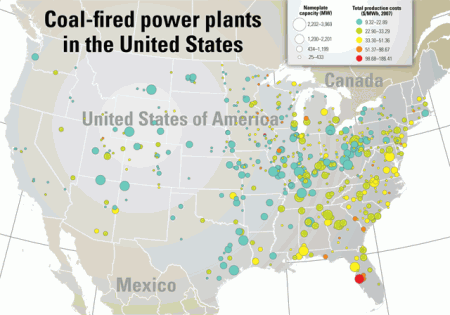Aug
3
Electricity Prices Should Go Higher
August 3, 2011 | 4 Comments
ICF International a major consulting firm has let slip two news reports out of their research that should cause consumers to perk up and get on with conservation, energy saving and cost cutting measures.
In the broad sense the two reports are showing a shortfall in generating capacity coming over the rest of the decade.
The earliest report discusses the shutdown of a large number of small coal generation plants totaling 50 gigawatts.
The later report is showing new natural gas generation plant increases to be 40 gigawatts.
That’s a 10 gigawatt difference. 10 gigawatts is a lot of wind turbines.
The earlier study highlights the near-term impacts of global economic recovery on U.S. energy markets and examines the implications of lower CO2 prices on the long-term energy outlook. Add to that the Environmental Protection Agency (EPA) has released proposals for the Clean Air Transport Rule (CATR), the Air Toxics Rule, coal combustion residuals, and cooling water intake structure standards. Those are the big motivators.
This isn’t all bad – much of the coal generation is going to be small, less efficient and older plants. The closings will clean things up.
Yet the costs from generation in old, long since paid for plants using cheap coal is going to be replaced by new facilities, with more costly natural gas fuel. One can expect that rate increases are going to come, and the increases could be quite substantial.
The later study cuts the suggested coal generation losses back to match the new natural gas generation.
ICF suggests there are differences, which should be expected, about contrary projections indicating environmental regulations will severely impact U.S. coal production, ICF projects that U.S. coal production will be maintained at more than 1 billion tons per year in the long-term despite the projected retirement of nearly 40 GWs of coal-fired electric generation in response to new environmental regulations and relatively low natural gas prices.
The ICF study also finds that increasing demand for renewable energy credits along with the loss of key federal incentives will cause renewable energy credit prices in eastern states to rise sharply over the next 15 years. Similarly, California will fall short of the state’s bundled interim requirements through 2016, maintaining upward pressure on delivered renewable energy credit prices. For folks and businesses in these areas this isn’t good budgetary news. But an early warning can make quite a difference on being ready.
The un addressed segment is the cost of natural gas. Its popular, and quite short sighted to expect that natural gas is going to stay cheap. Comparing the experience of natural gas to coal pricing is very revealing. The highs and lows of natural gas prices swing over a much larger range than coal prices. Granted, power companies can bargain, and will contract for long terms, but those huge power company contracts are going to pull product out of the rest of the natural gas market – particularly affecting home heating and industrial process heat. Home heating will be the last “marginal unit” priced product in the future.
The impact could well be a double hit, electrical power and heating.
With the economy in slow mode there could be a strong case made that long-term capital investment in conservation and efficiency would be lower cost now than when the economy heats up again. The time to get a deal might be now. For larger electric and gas users this might be a prime time to build in future savings.
There are no hard numbers for projections into the future for electricity and gas rates. But one can go far in cutting and eliminating one’s risk. From ground source heat pumps to LED lights the potential to see expenses go down has never looked better.
All one needs is a sense of surety about future income – that might be the main problem holding folks back. But to keep energy costs as a small share of ones’ budget, one is going to have to invest, and the timing looks good, now.
Comments
4 Comments so far



“So, if somebody wants to build a coal plant, they can — it’s just that it will bankrupt them, because they are going to be charged a huge sum for all that greenhouse gas that’s being emitted.” Barak Obama
He was wrong. Instead of taxing coal plants to death, he is using the EPA to shut them down.
Oh well. Who needs air conditining? We are just the little people. We can just sweat all summer. But, my guess is that the compressors are humming at the EPA and the White House.
I agree with Matt. This `giga gap` is a politically manufactured one. The blog ought to cover that aspect of the whole issue.
Hello would you mind stating which blog platform you’re using? I’m going
to start my own blog soon but I’m having a difficult time selecting between BlogEngine/Wordpress/B2evolution and Drupal. The reason I ask is because your design and style seems different then most blogs and I’m looking for something unique.
P.S Apologies for being off-topic but I had to ask!
Nice post. I learn something new and challenging
on blogs I stumbleupon every day. It will always be exciting
to read content from other authors and practice a little something from other sites.